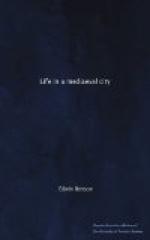Books, which had all to be written by hand, were scarce. The copying of manuscripts, which was done mostly in the monasteries, was laborious work. Instruction was given as a rule orally, but also by means of pictorial art and drama. The stained-glass windows were more than ornamental additions to the church building: they were part of the means of instruction. Mediaeval drama had originated in the Church’s effort to make events described in the gospel more real through their representation dramatically.
The teaching of manual skill and craftsmanship was entirely the work of the masters of the crafts under the general supervision of the guilds. The work of the age was made beautiful, and being handwork each piece of work gained the interest of individuality. The details of architectural ornament, in consequence, show wonderful diversity of form. The naive spirit of the ordinary handicraft workman was often reflected in his work. The arts of the goldsmith, silversmith, bell-founder, vestment-maker (which required elaborate embroidery), and the sculptor, were practised in York with excellent results.
There has never been a university of York, although under Alcuin the school of York was doing work of high quality, work that gained European fame. Even within the last hundred years, when so many provincial universities and university colleges have been established, York, one of the most appropriate places, has not obtained a university.
News and information reached the citizens mainly from personal intercourse. Merchants visiting other cities discussed with fellow merchants not only their immediate business but also past and current events. Pilgrims, palmers, and sailors recited their adventures on distant seas and lands, and told of the wonders of the world. The ordinary citizen, who read little, depended on conversations with better-informed citizens and strangers. The city council was continually in communication with the King and the great officers of State: information filtered down from the council to the citizens. The messengers often supplied the latest semi-official news. Officials and servants attached to the royal service or to that of nobles or of ecclesiastics (like the Archbishop of York), were the source of much political gossip. The news of the country passed to and fro between the city and the monastic lands, the castles, the manors, and the forests by means of the visits of men who lived at those places. Markets and fairs and public assemblies, whether the holding of assizes or on State visits, were occasions for the dissemination of news. The ordinary citizen gathered news and information also from the pulpit and from guild and parochial meetings, and from the bellman. The only authoritative news he received at first hand he got by listening to the public reading of proclamations.
In the Middle Ages educated men who had no inclination for the life of the Church, monastic or secular, nor for landed proprietorship, with which was combined hunting and soldiering, became clerks. The clerks in the royal service helped in the work of administration of national affairs. Tradesmen’s sons of ability and opportunity succeeded in gaining good positions in this service. Nobles also employed clerks.




